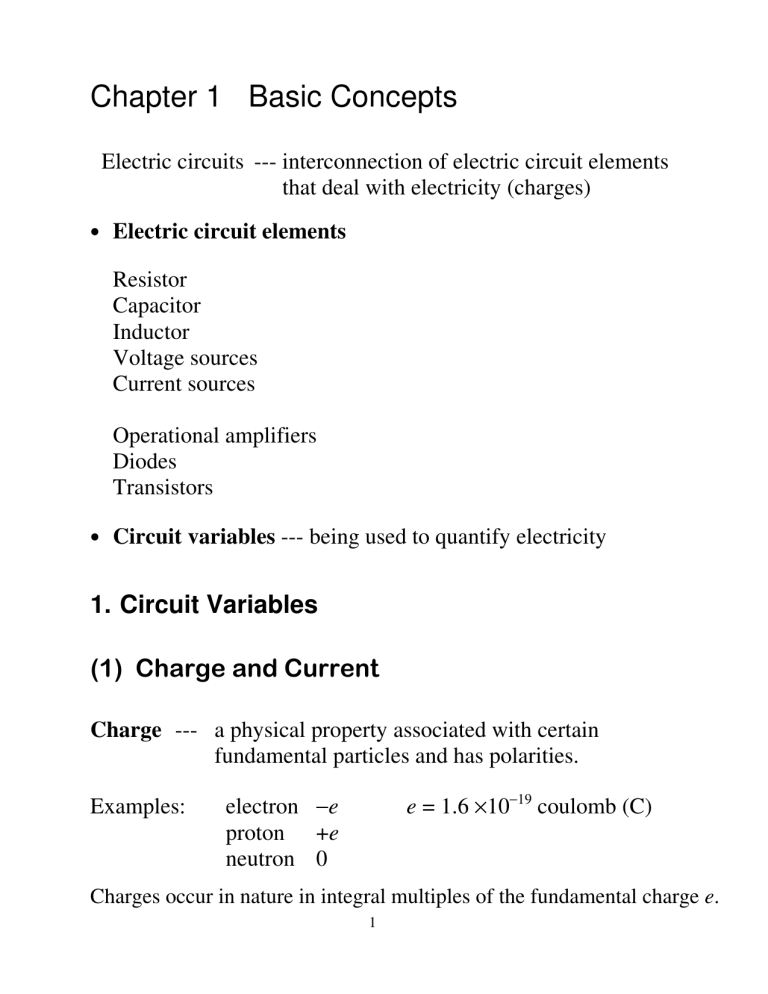
Chapter 1 Basic Concepts Electric circuits --- interconnection of electric circuit elements that deal with electricity (charges) • Electric circuit elements Resistor Capacitor Inductor Voltage sources Current sources Operational amplifiers Diodes Transistors • Circuit variables --- being used to quantify electricity 1. Circuit Variables (1) Charge and Current Charge --- a physical property associated with certain fundamental particles and has polarities. Examples: e = 1.6 ×10−19 coulomb (C) electron −e proton +e neutron 0 Charges occur in nature in integral multiples of the fundamental charge e. 1 Law of conservation of charge ---- Charges can neither be created nor destructed, only be transported. Current --- the time rate of transporting charges across a cross-section area. = unit: ampere (A) = ( ) • Must have reference direction positive charges flow in the reference direction, or negative charges flow in the opposite direction opposite situations • A direct current (dc) is constant in time • An alternating current (ac) changes sinusoidally in time 2 (2) Voltage How to make charges move? → under electric force → electric potential difference • U --- electric potential at a given point in a circuit • Voltage = electric potential difference between two points ≡ − • Voltage has polarities “+” terminal --- (reference) high potential point “−” terminal --- (reference) low potential point ≡ − = voltage drop from "" point to "" point = voltage rise from "" point to "" point • Electric potential energy of ∆q charge at a given point " = ∆ Electric potential energy difference in moving ∆q charge between "" and “−” points ∆" = ∆ ( − ) = ∆ " = unit: volt (V) 3 *+ *, = electric energy loss when unit positive charge (∆ = +1 /) moving from "" to "" points ( = ) − ) = = electric energy gain when unit positive charge moving from "" to "" points Default statements can be rephrased with negative charge and/or different direction. (3) Power --- the time rate of supplying or absorbing energy 0= " " = 0( ) • In electric circuits, power is associated with moving charges 1= *+ *+ *, = = 34 *2 *, *2 • p>0 power is absorbed by the element p<0 power is supplied by the element • Law of conservation of energy (power) sum of power absorbed = sum of power supplied or ∑6 06 = 0 (supply and absorb have opposite signs) 4 2. Circuit Elements (basic, two-terminal elements) • Passive circuit elements Resistor Capacitor Inductor • Sources (active circuit elements) independent source (value specified) 89 value specified dependent source (dependence specified) Voltage source 89 = :8; (89 () specified, or 9 to be determined) 89 = <; --------------------------------------------------------------------------------------Current source 9 value 9 = =8; (9 () specified, specified or 89 to be determined) 9 = >; --------------------------------------------------------------------------------------------------- 8; ?@ ; is the voltage or current at other location of the circuit. 5 Examples 70-V is an independent voltage source 28; is a dependent voltage source 9-A is an independent current source B /4 is a dependent current source 6 Passive Sign Convention (Sign used in power equation and device-law equations for any twoterminal element based on the voltage polarity and current direction) Use "" sign in equation Use "" sign in equation Example Consider 8 > 0 and positive charges entering "" terminal So the positive charges lose energy. In 1st case, use "" sign in the power equation 0 = +8 >0 (+ move along current reference direction) o 0>0 (FGFHFI JKL?@KIM 0?NF@) In 2nd case, use "" sign in the power equation 0 = −8 < 0 (+ move opposite to current reference direction) o 0>0 (FGFHFI JKL?@KIM 0?NF@, LJHF @FLQG) 7 Example Find power for each element. 4 circuit elements in the circuit. 2 elements information given. Two more pieces information needed. Let’s make measurements to get two more pieces of information. RS = 9 U, RV = R; = 5 U → dependent voltage source value 0.6 R; = 3 , [ = V = 3 \ = 2 + 3 = 5 R[ = 9 − 5 = 4 U 0\ = −5 × 9 U = −45 " LQ00G^ 0S = +2 × 9 U = 18 " JKL?@K (QIF@ `ℎJ@MIM) 0V = +3 × 5 U = 15 " JKL?@K 0[ = +3 × 4 U = 12 " 0\ + 0S + 0[ + 0V = 0 8 JKL?@K `?ILF@8J?I ?b 0?NF@



